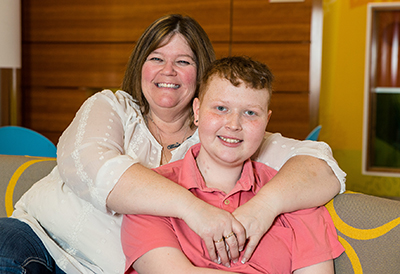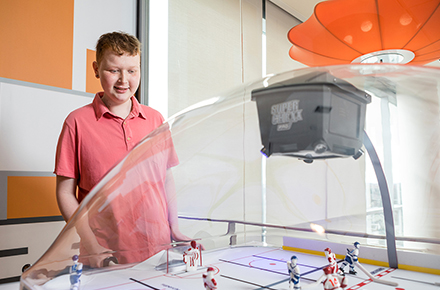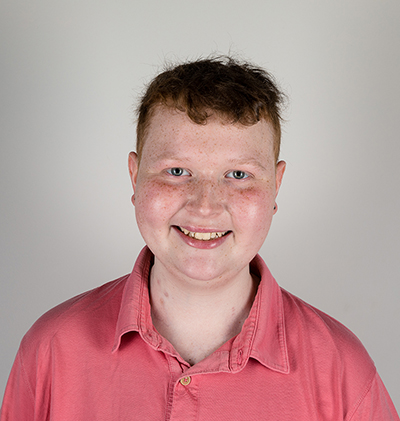Zach Losee
 Teen Brought Back to Life after Sudden Heart Failure
Teen Brought Back to Life after Sudden Heart Failure
Sirens blaring in the background, Zach Losee gasped for air as paramedics rushed him into the hospital. He looked up at his mom’s panicked face and used all his energy to take one more breath.
Within seconds, dozens of nurses and doctors surrounded him and began working in a fury. Zach could hear them talking, but their words were jumbled, and soon, their faces began to blur.
“He’s turning blue,” one doctor said. “Does anybody have a pulse?”
Zach’s mother held his hand and desperately tried to keep his attention.
“We are where we need to be. It’s going to be OK,” she told him.
But in the next moment, she saw Zach’s eyes close. His hand went limp in hers.
‘We Thought it Was a Cold’
Just nine days earlier, Zach, a freshman at Brockport High School, was playing in a JV volleyball match. He was healthy — a completely normal 15-year-old.
So when he started to feel under the weather, Zach and his mom assumed it was a cold, or, at worst, the flu.
“We thought it was a little viral thing that had been going around,” said his mom, Julie Prest. “He stayed home from school, and I made him chicken noodle soup.”
But within hours, Zach’s health took a drastic turn for the worse, and he felt weaker than he ever had before. Julie brought him to the emergency room at Strong West, and on their way through the door, Zach collapsed. Doctors knew he had to be transported to Golisano Children’s Hospital.
“The ambulance ride is a total blur,” said Julie. “I remember them asking us questions and talking to Zach, trying to get him to stay with us.”
Later, Julie found out that Zach’s heart had stopped on the ambulance ride — twice — and paramedics had to give him epinephrine to restart it.
By the time he made it to the hospital, Zach was barely alive.

Zach with his mom, Julie.
Keeping Zach Alive
“When he came into the emergency room, Zach’s heart function was so poor that it couldn’t maintain adequate blood flow to his organs,” said Jill Cholette, M.D., medical director of the Pediatric Cardiac Intensive Care Unit (PCICU). “His heart was failing, and so were his kidneys and his liver.”
The emergency department team inserted a breathing tube and whisked him upstairs to the PCICU. There, the team was able to stabilize him as much as they could, but his heart couldn’t continue to work on its own and it was clear that he was going to need additional support.
Zach was taken to the cardiac catheterization lab, where pediatric cardiac surgeon George Alfieris, M.D., cardiologist Rajiv Devanagondi, M.D., and the pediatric interventional cardiology team placed him on an advanced life support system. The machine, called extracorporeal membrane oxygenation (ECMO), acted as Zach’s heart and lungs, delivering oxygen to his blood and pumping it throughout his body.
Without ECMO, Zach would have died within an hour. But he was still facing long odds: Children who are ill enough to need ECMO have about a 50 percent chance of survival.
“At this point, Zach was alive, and that was a miracle,” said Cholette. “But we didn’t know why Zach’s heart was failing, so it was unclear if it was going to recover and be able to work on its own again.”
After days on ECMO, it became clear that Zach’s kidneys weren’t bouncing back on their own. So the nephrology team placed him on continuous renal replacement therapy, a form of dialysis for critically ill patients that works 24 hours a day.
Zach was now hooked up to two high-tech machines in the bay of the PCICU, where the hospital’s most critically ill patients reside.
“All I kept thinking was: ‘This is from a cold? Is this a dream?’” said Julie. “I couldn’t wrap my head around the fact that this was happening so fast.”
 Finding an Answer
Finding an Answer
Throughout Zach’s hospital stay and ongoing journey, Julie kept a detailed journal, documenting every visit from his doctors and each test he underwent.
“When the unthinkable happens, it’s easy to shy away, or curl up in the corner, crying,” said Julie. “But I found I had to throw myself into it and learn as much as I could.”
Her notes show detailed discussions with the doctors about what could have caused Zach — a previously healthy teenager — to go into sudden heart failure.
To get some answers, Devanagondi’s team took samples of his heart muscle and sent them to the lab for analysis. The results suggested that antibodies in Zach’s blood — which had been produced to fight an unidentified virus — had also attacked his heart, causing it to become weak and fail.
“It was the first I’ve ever seen this condition. It’s very, very rare, and it’s scary, because his initial symptoms could have never predicted what was to come,” said Cholette. “This is something that could happen to anyone.”
Zach’s care team started him on high-dose steroids and a treatment called plasmapheresis, which filtered his blood and removed the harmful antibodies. The treatments allowed his heart to get stronger, and after 19 days, he was able to come off ECMO.
“We had to explain to Zach what had happened to him, and it was difficult. He struggled with it — last thing he knew, he was out on the volleyball court,” said Julie. “But we were just grateful he was alive.”
As Zach got stronger, he moved from the bay of the PCICU to a room on the unit. He started physical and occupational therapy, and his kidneys rebounded, too.
 “The fact that Zach’s kidneys did recover significantly improved the chances that his outcome would be OK,” said nephrologist Marc Lande, M.D. “It was truly a collaborative effort to get him to this point.”
“The fact that Zach’s kidneys did recover significantly improved the chances that his outcome would be OK,” said nephrologist Marc Lande, M.D. “It was truly a collaborative effort to get him to this point.”
A Stepping Stone
Despite Zach’s progress, doctors determined that the ordeal had caused too much damage to his heart, and it wouldn’t be able to support Zach for much longer on its own.
The night before Thanksgiving, Zach was transported to a hospital in New York City. There, the team surgically implanted a heart pump, called a ventricular assist device, to support his heart while he waited for a transplant.
With a rare blood type and a shortage of donated organs for transplant statewide, Zach and Julie steeled themselves for a long wait. But to their surprise, a heart became available quickly, and he underwent a successful transplant in early December.
By mid-February, he was home.
Now, Zach is back at school. He’s catching up with his friends, and he’s looking forward to playing volleyball again in the fall. Life isn’t exactly back to “normal” yet, but it’s getting there.
Inspired by his journey, Zach hopes to be an advocate for organ donations, and he’d like to be a driving force in increasing services here at Golisano Children’s Hospital — so that someday, children like him will be able to have a heart transplant right here in Rochester.
“I am overwhelmed to know that I got a second chance at life,” said Zach. “I hope others will make the same decision that my donor did.”
Zach and his mom have been back to the hospital to visit a few times. They have a lot of people to see, including caregivers from a dozen different divisions who took part in his care. But the person Zach wanted to visit the most was Helen Witherspoon: a patient care technician who was by Zach’s side through his most challenging days.
“Everybody that we have met on this journey has impacted Zach, his recovery, and myself in such a way that we are so grateful to each and every one of them,” said Julie. “They saved his life.”
Make a Gift to Golisano Children's Hospital